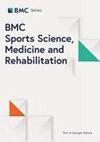中国新疆帕米尔高原塔吉克族青少年腰围与体能指数之间的性别差异:一项观察性研究
IF 2.1
3区 医学
Q1 REHABILITATION
引用次数: 0
摘要
有文献报道,腰围(WC)与青少年的体能有关。然而,关于腰围与体能综合指标--体能指数(PFI)之间关系的研究却较少。此外,目前还不清楚腹围与 PFI 之间的关系是否会因海拔、种族和性别的不同而发生变化。本研究进一步揭示了高海拔地区青少年腹围与 PFI 之间的相关性,为高海拔地区青少年的体质健康发展提供参考。本研究采用分层全人群抽样法,共选取了 1705 名 13-15 岁的塔吉克斯坦青少年。对体重和体能项目(握力、立定跳远、50 米短跑和耐力跑)进行了评估,并采用标准化方法计算了 PFI。通过曲线回归分析法分析了腹围和 PFI 之间的关系。中国新疆地区帕米尔高原 13-15 岁塔吉克族青少年的腹围和 PFI 的平均值和标准偏差分别为 68.26 ± 7.75 厘米和 - 2.00 ± 3.47。对不同WC的塔吉克族青少年组间的PFI进行比较后发现,组间比较具有显著效果,效应大小超过0.2。当男生的腹围为 61 厘米(-1.3207),女生的腹围为 60 厘米(-1.0556)时,塔吉克青少年的 PFI 达到最高值。塔吉克斯坦青少年的腹围与 PFI 之间的关系呈倒 "U "型曲线,没有性别差异。建议塔吉克斯坦青少年的腹围应控制在 60 至 61 厘米之间,以保持较好的 PFI 水平。该研究为中国新疆帕米尔高原的教育决策和公共卫生预防提供了支持和参考。本文章由计算机程序翻译,如有差异,请以英文原文为准。
Sex differences in the association between waist circumference and physical fitness index among Tajik adolescents in the Pamir Mountains of Xinjiang, China: an observational study
It has been reported in the literature that waist circumference (WC) was related to physical fitness in adolescents. However, the association between WC and PFI(physical fitness index), a comprehensive indicator of physical fitness, has been less studied. In addition, it is not clear whether the association between WC and PFI changes depending on altitude, ethnicity, and sex. This study further revealed the correlation between WC and PFI among adolescents in high-altitude areas and provided references for the physical and healthy development of adolescents in high-altitude areas. In this study, a total of 1705 Tajik adolescents aged 13–15 years were selected using stratified whole-population sampling. WC and physical fitness items (grip strength, standing long jump, 50 m dash, and endurance run) were assessed and a standardized method was used to calculate PFI. The association between WC and PFI was analyzed by curvilinear regression analysis. The mean and standard deviation of WC and PFI for Tajik adolescents aged 13–15 years old on the Pamir Plateau in Xinjiang, China, were 68.26 ± 7.75 cm and − 2.00 ± 3.47 respectively. Comparison of PFI between groups of Tajik adolescents with different WC showed that inter-group comparisons had significant effects with effect size above 0.2. The Tajik adolescents’ PFI reached its highest when WC was 61 cm for boys(-1.3207), and 60 cm for girls (-1.0556). The association between WC and PFI in Tajik adolescents showed an inverted “U” curve, with no sex difference. It is recommended that the WC of Tajik adolescents should be controlled between 60 and 61 cm to maintain better PFI levels. The study provides support and reference for educational policy-making and public health prevention in the Pamir Plateau in Xinjiang, China.
求助全文
通过发布文献求助,成功后即可免费获取论文全文。
去求助
来源期刊

BMC Sports Science Medicine and Rehabilitation
Medicine-Orthopedics and Sports Medicine
CiteScore
3.00
自引率
5.30%
发文量
196
审稿时长
26 weeks
期刊介绍:
BMC Sports Science, Medicine and Rehabilitation is an open access, peer reviewed journal that considers articles on all aspects of sports medicine and the exercise sciences, including rehabilitation, traumatology, cardiology, physiology, and nutrition.
 求助内容:
求助内容: 应助结果提醒方式:
应助结果提醒方式:


